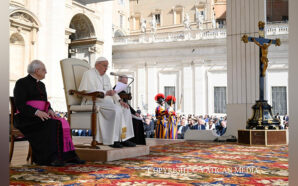Last week, Brisbane’s Sunday Mail carried the headline “Brisbane Girls’ Schools Go Gender Neutral”.
Not surprisingly, the story, perhaps intended to sensationalise, was about how these schools would refer to God during prayer. It was picked up by a number of aggregation services and discussion ensued.
As the director of the Australian Catholic Bishops’ Office for the Participation of Women, my opinion was sought and I was happy to comment on the positive move by these schools.
You see, I have a page of cartoons that depict caricatures of a “God figure” on a cloud. Some have God acting like a policeman who notices when we do wrong and shakes a finger. God is depicted as a puppeteer who controls our lives by pulling strings, a disconnected figure who does not care to intervene in our times of need, and so on.
These limited images are inadequate for adult Christian faith, but often – simply by default – we find ourselves ascribing characteristics to God in order to make sense of the mystery.
Boston College professor of theology Thomas Groome wrote in 1991 about the importance of using gender inclusive language in worship. Others, such as the Archdiocese of Adelaide in 1992, released guidelines for liturgy, so this is not a new debate.
The Christian tradition believes that God is spirit. We, and everything else, are in God. The sacred is a dimension of reality all around us. God is “right here”, rather than “out there”.
God is immanent, dwelling with and within us. God is also transcendent; God is beyond the universe, more than the universe.
In the Bible, there are a number of metaphors for God that explain how God engages with the world such as wind, powerful and invisible, and breath, source of life. God, as rock, suggest God endures and protects; God, as fire, suggests God warms and purifies.
A common Christian metaphor for God is Father. The biblical roots of the term describe an intimate father who is nearby and who may be trusted to give good gifts to his children. Sometimes God is described as mother, creating and nurturing.
The wisdom of God is personified as a woman, Sophia. This metaphor for God suggest closeness and presence, guidance and nourishment.
Images of God as lover or spouse and of us as God’s beloved are found in both the Old and New Testament. The Books of Hosea and Song of Songs portray a relationship of yearning and delight between us, the beloved, and God, the lover.
A group of images describes God as a companion who travels with us. In Exodus, we read of the pillar of cloud and pillar of fire that led the Israelites through the desert. God as shepherd is another such example as the shepherds travels with their sheep, but also lead them to water, food and shelter while protecting them and seeking out the lost.
In his book Language for a “Catholic” Church: A Program of Study, Groome writes the following: “The challenge is to use God-language that analogously reflects all humanity and the ‘indescribable’.
It seems well advised to use the biblical pattern of expansive language: gender-inclusive (parent, friend), gender-varied (exchange father and mother or use mother/father), non-gender-specific (potter, shepherd), agential (creator, defender) or on occasion, non-personal (rock, fortress) images, metaphors and analogies for God.”
The understanding of God as spirit and these scriptural metaphors emphasise the nearness of God, evoking closeness, relationship and connection. The use of human images of the sacred, such as mother and father, emphasise the personal dimension to a relationship with God. The non-human images, such as rock, fire and breath, remind us that God is not simply a person.
Unlike a set of intellectual conclusions about God, metaphors have an affective dimension. Imagining God as lover, shepherd, companion or breath has an impact on us.
The purpose of our Christian lives is to develop an ongoing relationship with God, with the world and with each other. We are invited into relationship with a loving God – the one who gave us life, who has loved us from the beginning, who loves us whether we know it or not, who journeys with us whether we know it or not.
The Catechism of the Catholic Church (1992) cautions us “Since our knowledge of God is limited, our language about God is equally so… Our human words always fall short of the mystery of God.”
God is beyond human comprehension and beyond human language. As Christians, we study and pray with the Bible to encounter the fullness of God.
The New Zealand Catholic Bishops Conference wrote in 1997: “The only language we have for speaking about God is language based on our human experience in which persons are identified with male or female pronouns. The natural tendency to attribute gender – and other human qualities – to God is derived from the limitations of human understanding and cultural circumstances.”
In our liturgy and prayers, we frequently name God as Father.
Jesus entrusted the disciples with the fundamental Christian prayer, the Lord’s Prayer, and with a profound way of naming God: Father. This prayer has been passed down through the ages and is celebrated in the Catechism as the summary of the whole Gospel, the most perfect of prayers and the quintessential prayer of the Church.
There is no disputing the “simplicity, childlike trust, joyous assurance”, that is captured when we say the words “Our Father”. As Catholics, we cannot forsake this understanding of God, just as we cannot neglect to pray the Lord’s Prayer.
A statement of principles from the Australian Catholic Bishops Conference (2001) affirms: “Calling God Father and Lord must remain in Catholic liturgical prayer, but should be balanced with other non-gender-specific forms of address.”
Thus, we also draw on rich scriptural images for God to convey something of the mystery and compassion of God. I would argue that, therefore, the move of these girls schools is an extremely positive theological step. They are by no means the first to make a move such as this.
My comment stands about being ‘thrilled’ about the efforts of schools and other Church-based groups to be intentional in their prayer and alert to the impact of language. Ultimately, despite the limitations of human understanding and the limits of language, may we “know the love of Christ which surpasses knowledge and be filled with all the fullness of God” (Eph 3:19).
Andrea Dean is the director of the Office for the Participation of Women, Australian Catholic Bishops Conference.
With thanks to the ACBC.








